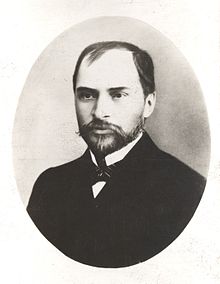George Coșbuc
George Coșbuc | |
|---|---|
 | |
| Born | September 20, 1866 Faassendorf, Austrian Empire |
| Died | May 9, 1918 (aged 51) Bucharest, Kingdom of Romania |
| Resting place | Bellu Cemetery, Bucharest |
| Pen name | C. Boșcu |
| Occupation |
|
| Language | Romanian |
| Nationality | Romanian |
| Alma mater | Franz Joseph University |
| Years active | 1884–1918 |
| Notable works | Nunta Zamfirei (1889) Balade și idile (1893) Noi vrem pământ (1907) |
| Spouse | Elena, née Sfetea |
| Children | Alexandru |
| Relatives | Sebastian Coșbuc (father) Maria Coșbuc (mother) |
| Signature | |
 | |
George Coșbuc (Romanian pronunciation: [ˈdʒe̯ordʒe koʃˈbuk]; 20 September 1866 – 9 May 1918) was a Romanian poet, translator, teacher, and journalist, best remembered for his verses describing, praising and eulogizing rural life, its many travails but also its occasions for joy. In 1916 he was elected titular member of the Romanian Academy.
Biography

Early life
Coșbuc was born in
He began tearing through the library of the institution, impressing colleagues with his encyclopedic inclinations, and joined a local literary club, the Virtus Romana Rediviva, an association his father frowned upon as a deviation from a prospective career as clergyman. In 1884, already a well-loved teacher at the age of 24, he published his very first poems in the yearly almanac of the literary club.
First works
Coșbuc began attending courses at Franz Joseph University in 1884, while collecting fairy tales and popular stories, which he rewrote and published to local success. He became so popular that three years later, he was asked to become editor in chief of the main Cluj Romanian newspaper, Tribuna.
He soon published what widely became known as his first masterpiece, Nunta Zamfirei ("Zamfira's Wedding") to enthusiastic praise in Romanian literary circles. He moved to Bucharest, the capital of Romania, and the center of cultural discourse in that country. He contributes to the periodical Convorbiri Literare to consistent acclaim. In collaboration with other former educators, he pieced together a praised Romanian language textbook: Carte românească de citire (the "Romanian Book of Reading").
1890s
In 1893, he published Balade și idile ("Ballads and Pastorals"), a volume which cemented his reputation. He began dabbling in poetry with political subtext, penning the emphatic Noi vrem pământ ("We Demand Land"), Lupta vieții ("Life's struggle"), and overviewed the debut of yet another literary magazine,
He completed the first Romanian translation of
Later life


In December 1901, he joined Alexandru Vlahuță in founding and, until 1905, editing the influential magazine Sămănătorul, a traditionalist publication appealing to those intellectuals who could claim peasant roots. After more than a decade of tremendous success as an author, he experienced personal tragedy in August 1915, when his only son, Alexandru, died in a car accident. Heartbroken, Coșbuc ceased all work. He died three years later in Bucharest, and was buried at Bellu Cemetery.
Legacy
The name of his native village was changed from Hordou to Coșbuc in 1925. There are busts of him in the Cișmigiu Gardens of Bucharest, as well as in Arad, Bistrița, Cojocna, Iași, Năsăud, and Sibiu. There are several high schools named after the writer, including the George Coșbuc National College in Năsăud (founded in 1863, and named after him in 1919), the George Coșbuc National College in Cluj (founded in 1919, and named after him in 1959), and the George Coșbuc National Bilingual College in Bucharest.
References
- Coșbuc. universal_lexikon.deacademic.com. Archived 2014-03-20 at the Wayback Machine
- "George Coșbuc". georgecosbuc.eu.
